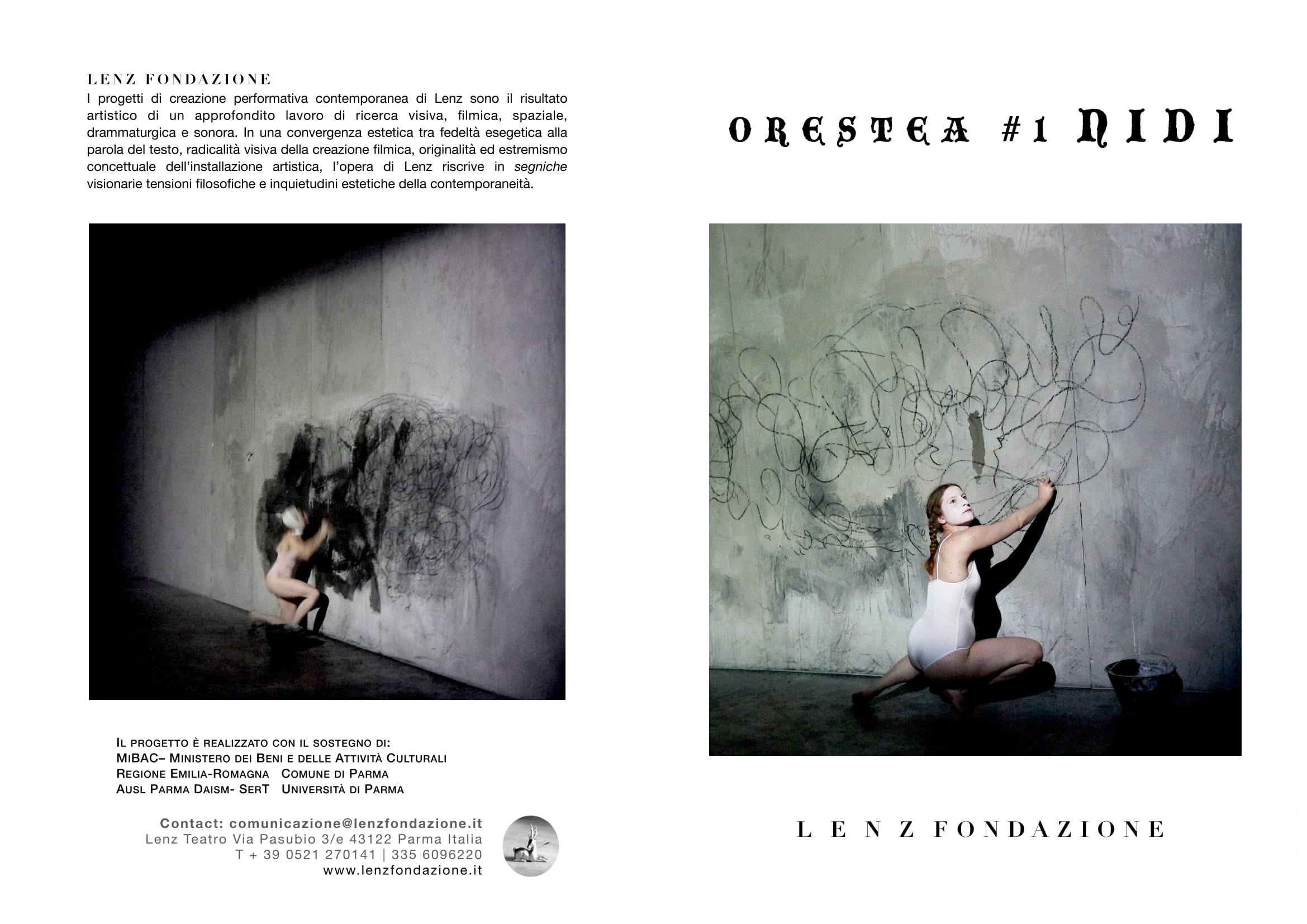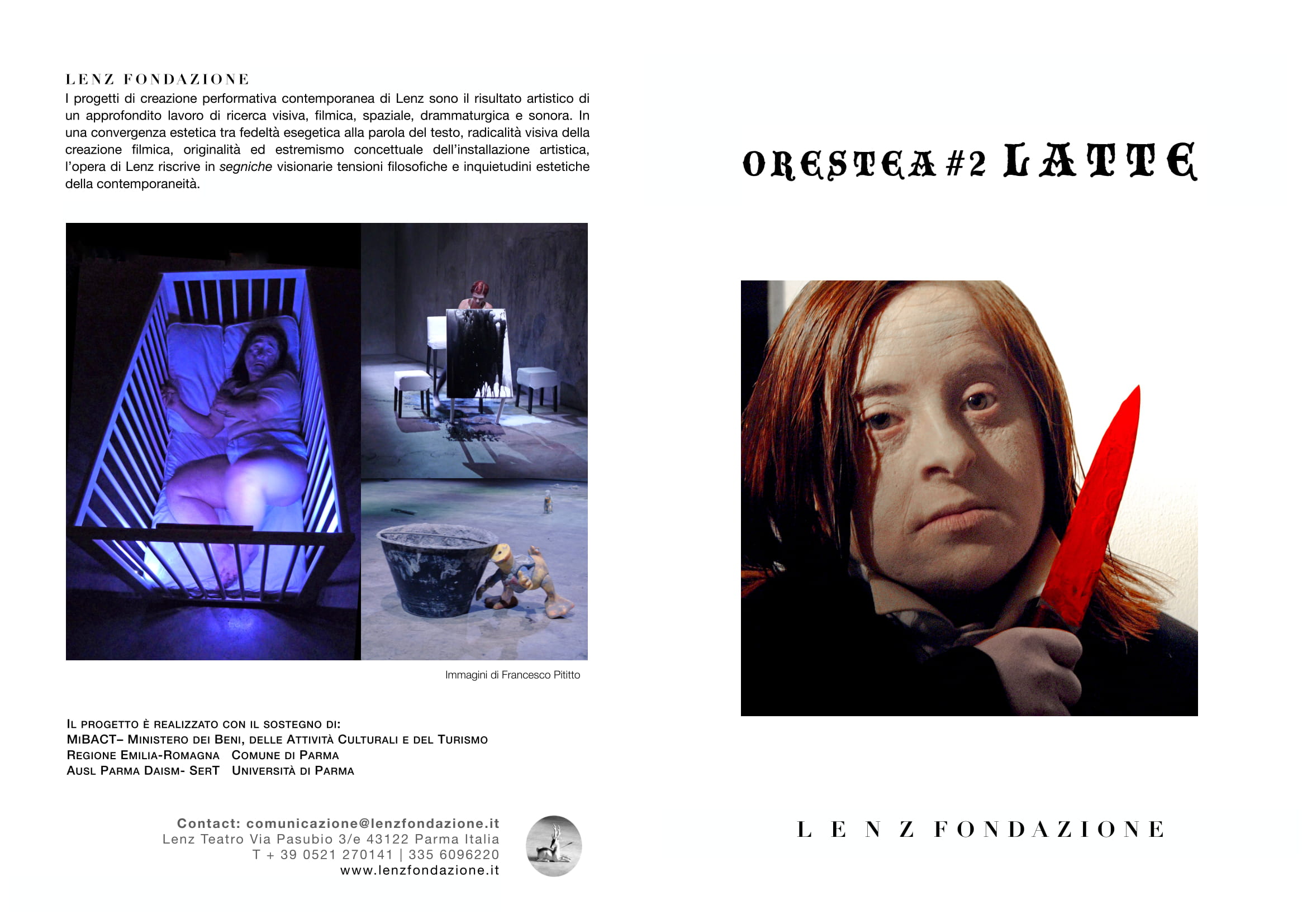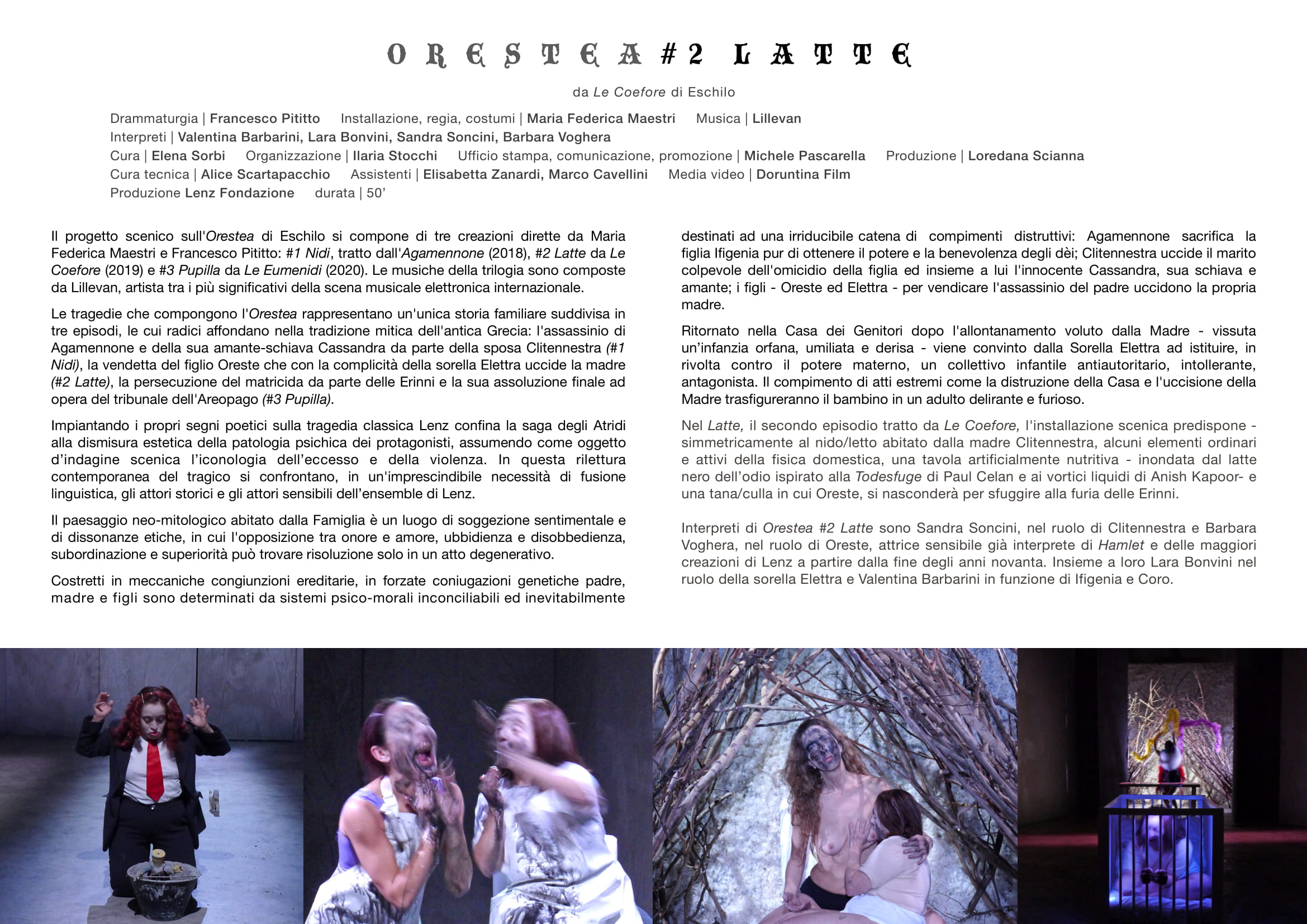
ORESTEA (Oresteia)
ORESTEA [Oresteia] from Aeschylus
Four-year project 2018-2021
#1 NIDI [Nests] from Agamennone
#2 LATTE [Milk] from Le Coefore
#3 PUPILLA [Pupil] from Le Eumenidi
The tragedies that make up the Oresteia of Aeschylus represent a single family story divided into three episodes, whose roots are rooted in the mythical tradition of ancient Greece: the murder of Agamemnon and his lover-slave Cassandra by his wife Clytemnestra (Agamemnone), the revenge of his son Orestes who with the complicity of his sister Electra kills his mother (Le Coefeore), the persecution of the matricide by the Erinni and his final acquittal by the court of the Areopagus (Le Eumenidi).
The scenic project directed by Maria Federica Maestri and Francesco Pititto consists of three creations: #1 Nidi from Agamennone, #2 Latte from Le Coefore and #3 Pupilla from Le Eumenidi; the powerful sound translation of the trilogy is designed by Lillevan, one of the most significant artists on the international electronic music scene.
For a contemporary rereading of the origins of the tragic, the sensitive actresses and the historical actresses of the ensemble confront each other in an unavoidable need for fusion and in a close scenic dialogue.
By implanting their poetic signs on classical tragedy, the Atridi saga is confined to the aesthetic immensity of the psychic pathology of the characters, assuming the iconology of excess and violence as an object of scenic investigation. Forced into mechanical hereditary conjunctions, into forced genetic conjugations father, mother and children are determined by irreconcilable psycho-moral systems and inevitably destined to an irreducible chain of destructive accomplishments: Agamemnon sacrifices his daughter Iphigenia in order to obtain the power and benevolence of the gods; Clytemnestra kills the spouse guilty of the murder of his daughter and with him the innocent Cassandra; the sons – Orestes and Electra – to avenge the murder of their beloved father kill their mother.
The protagonists of the tragedy inhabit neo-mythological landscapes, places of moral coercion and emotional detention in which fears, horrors, passions that starve and devour the body of the family are stratified. The scenic òikos inhabited by the Family is a space of sentimental awe and ethical dissonances, where the opposition between honor and love, obedience and disobedience, subordination and superiority can only find resolution in a degenerative act. Killed his mother and destroyed the house, Orestes tries to escape punishment for his crime against nature and takes refuge in a place of transit, anonymous and hostile, guarded by multiple figures of his mother. The Erinni amplify the violence and desire for revenge of Clytemnestra. Not even the sedating presence of the righteous gods, Athena and Apollo, can compensate for the damage, repair the evil, but heavenly vertebrates can only turn pain and anger towards emotional dullness, towards an eternal saving sadness.
#1 NIDI [NESTS] from Agamemnon by Aeschylus
In the first chapter of the trilogy the extreme state of feeling, the passion that moves and pushes towards death, the tragic killing of the hero, the mystery of the human condition take shape in the oscillation between weakness and strength, vulnerability and power of Cassandra’s psychic body, the foreign prophetess of misfortune, prey of war and slave in the house of the Atrides, refracted ray of Clytemnestra’s poetic and violated physics.
The installation in the first chapter highlights a pedestal nest that draws formal inspiration from the work of Mario Merz, in which the female characters of the tragedy – Clytemnestra and Cassandra – lay and brood their eggs. The desecration of the nest triggers the tragic conflict between the forces, the irreparable act that marks its double death.
The interpreters of #1 Nidi are Sandra Soncini, protagonist of the most important creations of Lenz in the role of Clitennestra, and Carlotta Spaggiari, sensitive actress, in the role of Cassandra, already extraordinary incarnation of Ermengarda in Adelchi and Angelica in the cycle inspired by Orlando Furioso; together with them, in the function of Iphigenia and Coro, Valentina Barbarini, icon of Lenz and interpreter of Iphigenia in Aulide, first paragraph of the diptych inspired by the myth of Iphigenia.
#2 LATTE [MILK] from Le Coefore by Aeschylus
Returning to his parents’ home after the estrangement wanted by his mother – who had lived an orphaned, humiliated and mocked childhood – Oreste was convinced by his sister Elettra to establish an anti-authoritarian, intolerant, antagonistic child collective in revolt against the maternal power. The accomplishment of extreme acts such as the destruction of the house and the killing of the mother, guilty of the murder of the king and father Agamemnon, transfigure the innocent child into a delirious and furious adult.
In Latte, the second episode taken from Le Coefore, the scenic installation sets up – symmetrically to the nest/bed inhabited by his mother Clytemnestra – some ordinary and active elements of domestic physics: an artificially nutritious table – flooded with the black milk of hate inspired by Paul Celan’s Todesfuge and Anish Kapoor’s liquid vortexes – and the den/cradle in which Orestes will hide to escape the fury of the Furies.
Starring in #2 Latte are Barbara Voghera, in the role of Oreste, a sensitive actress already playing Hamlet and the major creations of Lenz and Sandra Soncini, in the role of Clitennestra; together with them Lara Bonvini in the role of her sister Elettra and Valentina Barbarini as Iphigenia and Coro.
#3 PUPILLA [PUPIL] from The Eumenides by Aeschylus
In the final episode of the trilogy, the persecution of the matricide Orestes by the Erinni and his final acquittal by the court of the Areopago. Protagonists of the last act are the divinities: Orestes, the Shadow of Clytemnestra, Athena, Apollo and the Furies. In Pupilla, the third episode taken from Le Eumenidi, the scenic installation prepares, after the destruction of the house by Orestes, a non-domestic space functionally referable to the waiting room of a public service; in this anonymous place, sanitized by the emotional violence that tragically transfigured them, the members of the family hope to rectify their identity and regain possession of a new destiny.
Performers of #3 Pupilla are Barbara Voghera in the role of Oreste, Sandra Soncini for Clitennestra’s Shadow, Monica Barone – former interpreter of Goethe and Gluck’s Iphigenia in Tauride – in the role of Atena, Carlotta Spaggiari in the role of Apollo, Valentina Barbarini and Lara Bonvini in the role of Coro ed Erinni.
Rewriting and dramaturgy | Francesco Pititto
Installation, direction, costumes | Maria Federica Maestri
Music | Lillevan
Care | Elena Sorbi
Organization | Ilaria Stocchi
Press office, communication, promotion | Michele Pascarella
Technical care | Alice Scartapacchio, Lucia Manghi
Assistant | Marco Cavellini
Production | Lenz Fondazione
#1 NIDI [NESTS]
from Agamennone by Aeschylus
Interpreters | Valentina Barbarini, Sandra Soncini, Carlotta Spaggiari
durata | 55’
#2 LATTE [MILK]
from Le Coefore by Aeschylus
Interpreters | Valentina Barbarini, Lara Bonvini, Sandra Soncini, Barbara Voghera
durata | 50’
#3 PUPILLA [PUPIL]
from Le Eumenidi by Aeschylus
Interpreters | Valentina Barbarini, Monica Barone, Lara Bonvini, Sandra Soncini, Carlotta Spaggiari, Barbara Voghera
durata | 45’
full:
Always on the continuous and severe sound fabric of the German electronic musician and composer Lillevan, bestiality and humanity will clash, pity and yoke will diverge, prophecies and curses will be annihilated. Cassandra will become first a bird, then a wolf walking on all fours; Clitennestra instead swan, simulating the death of the other. On the cyanicovskiane notes of the “Death of the Swan”, she, telluric body, squashed, crazy, will dance frantically in a perturbing choreographic sequence at such a high physical and emotional rate to remain impressed in our memory as spectators. (more)
.
The tension, which accumulates without control for 50 minutes, leads to the final catharsis, the childbirth-death-compenetration of the two protagonists in a royal lair. (more)
Emanuela Zanon, Juliet Art Magazine
In technical terms, Nidi embodies on the scene the ancient concept of the miasma […] each tragic picture always generates new and different horrors, this time without any apparent form of salvation […] Clitemnestra and Cassandra both show themselves lying on their beds, posing as birthing babies and even in labor, which however will only lead to the killing of the prophetess and Agamemnon. This is the point at which the miasma reaches its climax: even in the sacred act of birth, in fact, what arises is only new death and not an innocent life. (more)
Enrico Piergiacomi, Università degli Studi di Trento


















